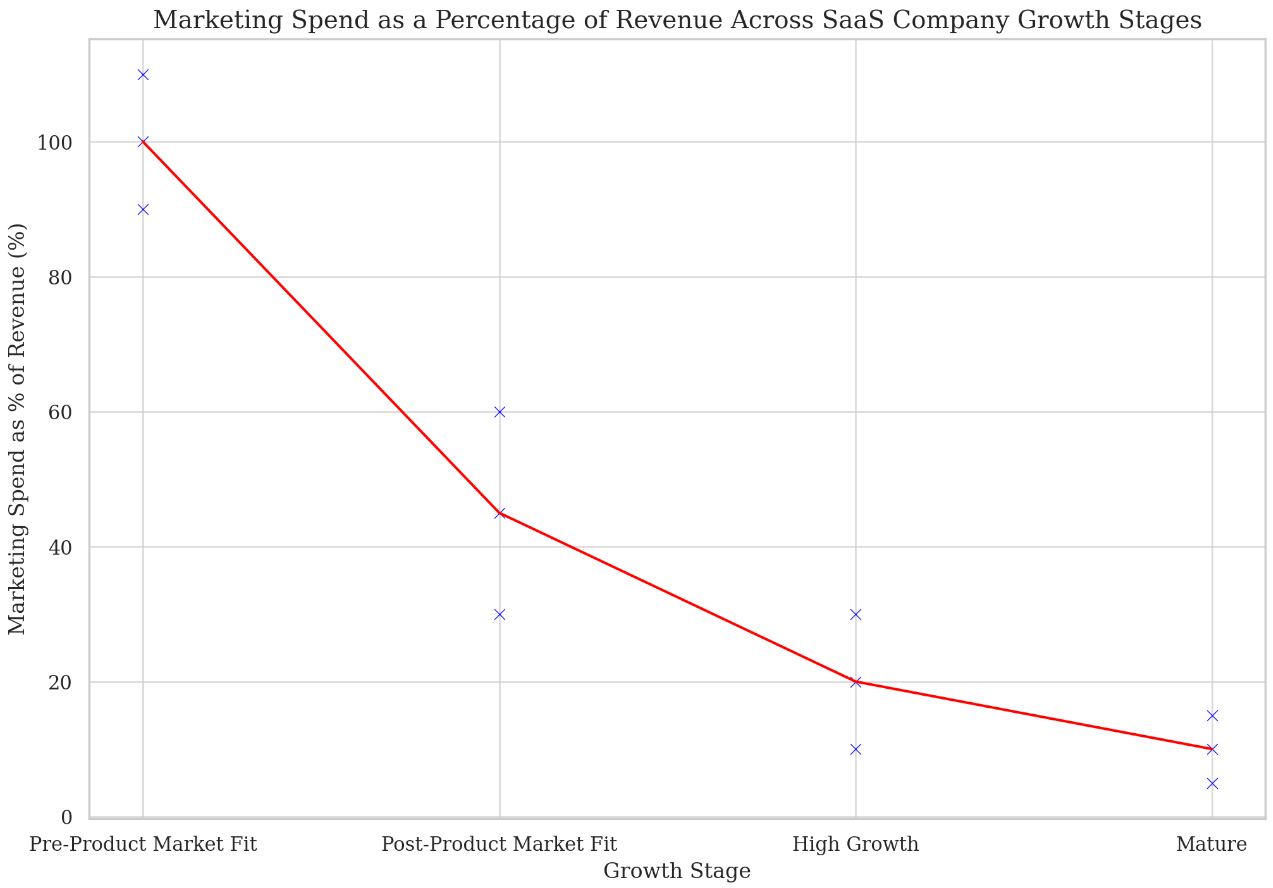"Marketing spend is like fuel for the fire of SaaS growth - pour too little and growth stalls; too much and cash burns too fast."
When I started my SaaS marketing agency, clients would pepper me with questions I struggled to answer confidently: "How much budget should I allocate on paid search vs. content marketing?" "What's the right spend for my stage of growth?" Without hard data and benchmarks, I was left guessing or relying on anecdotal evidence.
I knew I needed to deeply understand SaaS marketing spend dynamics if I wanted to guide clients strategically. So I made it my mission to gather hard spend benchmarks across SaaS growth stages and map out channel budget allocations scientifically.
After compiling data from hundreds of SaaS companies on their marketing budgets and priorities over time, I unlocked a framework for aligning spend strategies to any client's growth objectives. Whether advising an early-stage founder on gaining traction or an enterprise CMO on optimizing spend, I can now provide tailored guidance grounded in real metrics.
In this post, I want to share the insights on SaaS marketing spend that I wish I had starting out as an agency founder. By passing on what I’ve learned, I aim to provide a useful reference for both clients planning budgets and peers building advisory services. Let’s unpack the research!



Marketing Spend by Company Growth Stage
Marketing spend varies widely based on the growth stage of a SaaS company. Early stage startups have very different marketing needs and budgets compared to large enterprises.
Here is a look at typical marketing spend as a percentage of revenue across different growth stages:
Pre-Product Market Fit (Seed & Early Startup Stage)
- Marketing Spend as % of Revenue: 100%+
- Key Priorities: Finding product-market fit, building awareness
In the earliest startup stages when the product is still being defined and market fit is uncertain, companies need to invest heavily in marketing to build awareness and get feedback from early adopters.
With little or no revenue, marketing spend will make up the bulk of expenses. Pre-product market fit companies commonly spend 100% or more of revenue on marketing.
Post-Product Market Fit (Mid Stage Startup)
- Marketing Spend as % of Revenue: 30-60%
- Key Priorities: Scaling up sales & revenue
Once initial product-market fit is achieved, priorities shift to scaling up sales and revenue growth. Marketing spend as a percentage of revenue declines but still remains high at 30-60% typically.
This stage is all about pouring fuel on the fire - maximizing marketing channels and campaigns that are demonstrating traction to accelerate growth.
High Growth (Late Stage Startup)
- Marketing Spend as % of Revenue: 10-30%
- Key Priorities: Expanding market reach, optimizing profitable channels
For high growth SaaS companies scaling towards $100M+ in revenue, marketing spend begins to decline as a percentage of revenue to 10-30%.
The focus shifts from growth at all costs to expanding market reach in a sustainable way while optimizing profitable marketing channels.
Mature (Post-IPO & Public Companies)
- Marketing Spend as % of Revenue: 5-15%
- Key Priorities: Brand building, retaining market position
In the mature growth phase, marketing spend declines further to 5-15% of revenue or less. When scale has been achieved, the name of the game becomes retaining market position and brand building rather than aggressive growth.
Marketing spend dedicated to innovation, entering new segments, and brand advertising increases at this stage.
Marketing Spend Benchmarks
To put real dollar figures behind these percentages, here are typical marketing spend ranges across growth stages:
Pre-Product Market Fit
- Seed stage: $5,000 - $25,000 per month
- Early startup: $25,000 - $75,000 per month
Post-Product Market Fit
- Mid stage startup: $50,000 - $150,000 per month
High Growth
- Late stage startup: $100,000 - $500,000 per month
Mature
- Early public company: $500,000 - $5,000,000 per month
- Large public company: $1,000,000 - $25,000,000+ per month
Of course, these ranges are broad estimates - spend can vary significantly based on factors like sales & marketing headcount, product price point, target customer, and more. But this gives you a general idea of marketing budget size for SaaS companies at different growth stages.
Below we'll dig deeper into how these budgets get allocated across specific marketing channels.
Marketing Channel Budget Allocation
Beyond overall budget size, the channels where marketing dollars get invested is critically important.
Here is a comparison of how marketing spend typically gets allocated across channels in early vs. late stage SaaS companies:
Early Stage Startup Marketing Channel Allocation
| Channel | Budget Allocation |
|---|---|
| Paid Search | 10-20% |
| Paid Social | 10-20% |
| Content Marketing | 20-40% |
| PR & Outreach | 10-20% |
| Conferences & Events | 10-20% |
| Website & Funnel Optimization | 10-20% |
| Other (Surveys, Swag, etc.) | <10% |
Early stage startups need to take an experimental approach across channels to find product-market fit and double down on what gains traction. Content marketing, paid search/social, and conferences are critical for building awareness. PR and website optimization drive quality traffic. Budgets remain fluid to fuel growth.
High Growth SaaS Marketing Channel Allocation
| Channel | Budget Allocation |
|---|---|
| Paid Search | 10-30% |
| Paid Social | 20-40% |
| Content Marketing | 10-20% |
| PR & Outreach | 5-15% |
| Conferences & Events | <10% |
| Website & Funnel Optimization | 10-20% |
| Lifecycle Marketing | 10-20% |
| Other (Surveys, Swag, etc.) | <10% |
In high growth mode, budgets shift significantly towards scalable paid channels - paid search, paid social, and lifecycle marketing. Content marketing becomes more focused on targeted assets vs. awareness building. Conferences and PR play a smaller role. Profitability and ROI are measured closely across channels.
Factors That Impact Marketing Spend
While these benchmarks provide a useful starting point, many factors impact marketing budgets. Here are some of the key ones to consider:
Customer Lifetime Value (LTV)
The higher the LTV of a SaaS company's customers, the more budget they can justify spending on expensive marketing channels to acquire customers. Companies with LTVs exceeding $10k annually ($1k+ monthly) have much more marketing budget flexibility.
Payback Period
Some companies choose to cap marketing spend based on payback period. For example, only spending up to 3-6 months worth of a customer's ARR on marketing. The lower the desired payback period, the tighter marketing budgets may be.
Gross vs. Net Margins
Gross profit margins influence marketing budget size, while net margins determine how much of gross profit will be reinvested into marketing vs. other parts of the business. Higher gross margins = bigger marketing budget potential.
Funding Stage
Marketing spend will increase dramatically as startups raise larger rounds of funding. A $5M Series A round can support much more spending than pre-seed bootstrap mode.
Channel Efficiency
If a company is very optimized at converting marketing leads into sales on channels like organic search or content, they may be able to spend less driving volume. More leads lost = more budget needed.
Product & Business Model
Business model plays a key role - an enterprise SaaS company may need to spend much more on sales qualified leads but less on marketing to hit revenue goals compared to a self-serve product.
Competitive Landscape
In crowded markets with well-funded competitors, significantly more marketing budget may be needed to stand out and get noticed.
Key Takeaways
To wrap up, here are some of my key recommendations on marketing spend for SaaS companies:
Match marketing budgets to growth stage - invest aggressively to fuel growth pre-product market fit and in the rapid scale-up phase.
Allocate spending across channels based on growth stage - shift budget from awareness channels to paid acquisition as you scale.
Consider LTV, payback period, gross margins and other factors - higher LTV and margins enable bigger budgets.
Build models to measure ROI by channel and optimize accordingly. Prove the profitability of marketing.
Plan budgets based on benchmarks, but stay flexible - fuel what drives results.
Marketing spend is a complex area but critical to get right at each growth stage. Hopefully these benchmarks provide a solid starting point for mapping your own SaaS marketing budgets and priorities.
FAQ
What is the marketing budget for SaaS companies?
The marketing budget for SaaS companies varies substantially based on the company's growth stage:
Pre-product market fit: 100%+ of revenue. Budgets ranging from $5k-25k per month for seed stage startups to $25k-75k per month for early stage startups.
Post-product market fit: 30-60% of revenue. Budgets from $50k-150k per month typically.
High growth stage: 10-30% of revenue. Budgets from $100k-500k per month.
Mature stage: 5-15% of revenue. Budgets from $500k per month to over $1 million per month.
How to calculate SaaS marketing budget?
Factors to consider when calculating your SaaS marketing budget include:
Customer lifetime value (LTV) - The higher the LTV, the more budget you can justify spending on marketing.
Payback period - Some companies limit budgets based on an acceptable customer payback period of 3-6 months.
Gross margins - Higher gross margins enable larger marketing budgets.
Funding stage - Marketing budgets increase with larger funding rounds.
Channel efficiency - More optimized conversion from marketing to sales enables lower spending.
Competitive landscape - More competitors may require larger budgets to stand out.
How much does a company spend on SaaS?
According to Flexera's 2022 State of Tech Spend Report, companies spend an average of 10.7% of their IT budgets on SaaS applications. But the SaaS spend percentage ranges from less than 5% to over 25% depending on company size and industry.
How much do SaaS companies spend on sales?
SaaS companies typically spend around 50% of revenue on sales and marketing combined. Of that amount, around 60-70% is allocated to sales activities and 30-40% to marketing. So for a $10 million revenue SaaS company, the sales budget may be $3-4 million annually.
How much do B2B SaaS companies spend on marketing?
B2B SaaS companies target 10-35% of revenue on marketing depending on growth stage, according to SaaS marketing metrics. On average, B2B SaaS companies spend 20-25% of revenue on marketing based on industry surveys.
What is the SaaS pricing model?
The most common SaaS pricing models are:
- Per user pricing - Price based on number of users or accounts
- Tiered pricing - Multiple packages at different price points based on features
- Per usage pricing - Price based on usage metrics like API calls or storage
- Freemium - Free plan + premium paid plans
- Flat fee - Single set price regardless of usage
Many SaaS combine multiple models like per user + usage pricing.
What is the profit margin for SaaS?
Average profit margins for SaaS companies range from 10-20% before interest, taxes, depreciation and amortization (EBITDA). But high-growth SaaS companies often focus more on revenue growth vs. profitability. Mature public SaaS companies like Salesforce have 25%+ operating margins.
What is the formula for ROI in SaaS?
The formula for calculating SaaS ROI is:
ROI = (Gain from Investment - Cost of Investment) / Cost of Investment
Gain is the revenue and savings from the SaaS app. Cost is the subscription, implementation, and ongoing support costs.
How do I create a SaaS marketing plan?
Key elements of a SaaS marketing plan include:
- Set growth goals and KPIs
- Map your customer journey to identify gaps
- Audit existing marketing channels and assess effectiveness
- Allocate budget across top of funnel and bottom of funnel activities
- Build out calendar with campaigns, promos, and content plans
- Establish processes to measure marketing performance
Ongoing optimization based on data and results is critical.
What is the 40 rule of SaaS?
The 40% rule states that your SaaS customer acquisition costs (CAC) should be no more than 40% of your customer lifetime value (LTV). This ensures your marketing spend is profitable.
For example, if LTV is $2,000 per customer, CAC should be less than $800 to abide by the 40% rule.
What is the size of the SaaS market?
The global SaaS market size was valued at USD 215.1 billion in 2021 and is projected to grow from USD 257.47 billion in 2022 to USD 1298.92 billion by 2030, growing at a CAGR of 19.7% in the forecast period (2023-2030).
Are SaaS companies profitable?
Many high-growth SaaS companies focus more on revenue growth and market share over profitability. But mature SaaS companies can be very profitable due to subscription revenue and recurring gross margins in excess of 70% in some cases. Public SaaS leaders like Salesforce, Workday, and ServiceNow have all achieved profitability.
What are the key priorities for marketing spend at different growth stages?
Pre-product market fit: Finding product-market fit, building awareness
Post-product market fit: Scaling up sales & revenue
High growth: Expanding market reach, optimizing profitable channels
Mature: Brand building, retaining market position
Priorities evolve from aggressive customer acquisition to more brand building as companies mature.
How does marketing spend as a % of revenue vary by growth stage?
Pre-product market fit: 100%+
Post-product market fit: 30-60%
High growth: 10-30%
Mature: 5-15%
Percentage declines over time as revenue scales, but remains higher for faster growth.
What are typical marketing budgets for a $5M ARR SaaS company?
At $5M ARR (likely post-product market fit stage), marketing budget might be:
$1.5M - $3M per year
$125,000 - $250,000 per month
Marketing spend equivalent to 30-60% of revenue.
How should early stage startups allocate marketing spend across channels?
Early stage startups should take an experimental approach across channels like content, paid search, events, PR. Typical split:
10-20% paid search
10-20% paid social
20-40% content marketing
10-20% PR
10-20% events
How does marketing budget allocation evolve as companies scale up?
High growth companies shift budget to scalable paid channels:
10-30% paid search
20-40% paid social
10-20% content (more targeted)
5-15% PR
<10% events
What metrics influence how much a company can spend on marketing?
Key factors include:
- Customer lifetime value
- Payback period/ROI goals
- Gross margins
- Funding stage
- Channel efficiency
- Competitive landscape
Should you always aim to hit benchmark averages for marketing spend?
Benchmarks provide a useful starting point, but marketing should be tailored based on company-specific factors and continuously optimized based on performance data.
How can companies determine the right budget for a particular marketing channel?
Companies should test marketing channels across a range of budgets and optimize based on attributable ROI. Measure beyond just volume metrics to quantify true impact on business growth.
What are some signs you may be underinvesting in marketing?
Signs of underinvestment include slow & stalling growth, high CAC, long payback periods, poor brand awareness, and loss of market share to competitors.
What are leading indicators that marketing spend may be too high?
Indicators of overspending include consistently missing ROI targets, low conversion rates, high customer churn, and ineffective programs continuing without optimization.





